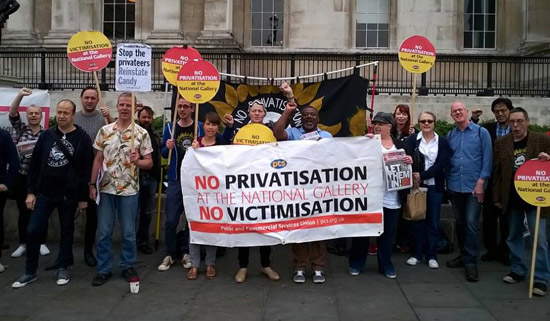While, here in Italy, many are still squabbling over the Pompeii workers’union assembly that raised a (pointless) fuss in late July, in London some 200 National Gallery employees belonging to the Public and Commercial Services (PCS) union have declared a strike that has been going on to the bitter end since yesterday. It is a substantial strike: as we learn from theIndependent, the museum’s total workforce numbers 600.
The reasons? Something very similar to what has already happened in Italy is happening in the British capital: as journalist Damien Gayle lets us know in a precise and timely article in the Guardian, the Gallery’s management has signed a contract to contract a private firm specializing in security tasks, called Securitas, to provide a range of services related tovisitor reception. The workers hired by the firm will be responsible, for example, for checkroom, security, but also for the custody of the halls, and the risk that the National Gallery workers fear (besides, of course, losing their jobs or having their hours reduced) is that in the future they may find, for the museum halls, staff completely unfamiliar with art history, with no knowledge of paintings, and therefore unable to give even minimal information to visitors. And we must not overlook the fact that many workers who are now on the Gallery’s payroll will move to the employ of Securitas: so one has to wonder whether this transfer will affect the employees’ contracts. Because Securitas is not only in charge of museums, but also of security at airports, offices, supermarkets, and businesses: people who have worked for a lifetime at the National Gallery could one day be transferred elsewhere.
 |
| The picket line of workers at yesterday’s strike at the National Gallery in London. Photo taken from the No Privatisation at The National Gallery Facebook page. |
It is Damien Gayle again who makes us aware of other possible effects of privatization that the Gallery workers are opposing. One of the workers is reported to have said that there is a fear that the National Gallery “will become less of an art gallery and more of a place to hang out, in short more of an amusement park than a museum.” Another worker, to the Guardian, bluntly stated that: “the National Gallery will be turned into a kind of Disneyland, and we don’t want that to happen at all.” Let us also not forget that visiting the National Gallery, like other British public museums, is free: there is also the fear that privatization may lead to the charging of an entrance fee. The climate, however, is quite tense, and this is but one of many strikes that have taken place at the London museum since the beginning of the year. As we learn from the BBC, there have been as many as 56 days of strikes in the Gallery since February, with even a 10-day non-stop strike in May, when unionist Candy Udwin, one of the staunchest protesters of privatization, was fired (by court order she has since been reinstated, but has not yet been allowed to return to work).
Also at the expense were, as is easy to imagine, visitors, who found most of the National Gallery rooms closed yesterday (and who nonetheless understood the reasons for the protest). Gayle, in her article, posted an image of a map of the museum with the rooms closed to the public due to the strikes (which we reproduce below). Anita Singh in the Telegraph also gave us a partial list of works that visitors were unable to view, starting with Van Gogh’s Sunflowers, one of the Gallery’s symbols, not to mention works by Constable, Seurat, Titian. And, we would add, all the Dutch works of the seventeenth century (Rembrandt, Rubens, van Dyck... ), all the Impressionists, most of the medieval Italian artists, the Venetian eighteenth century, and many, many more. In short: out of a total of almost seventy rooms, those open were just under twenty. This is the height of the tourist season, and we are not talking about a small provincial museum, but the second most visited museum in the whole of the United Kingdom (and fourth in the world ranking compiled by The Art Newspaper).
This is how much of the National Gallery has been shut down by today’s strike pic.twitter.com/BZvMmEqRif
- Damien Gayle (@damiengayle) August 11, 2015But despite this, public opinion, contrary to what often happens in Italy, is clearly siding with the workers: most recognize the importance of the strike and support the workers, wish them luck, and there are even some who wish the media would talk more about the protest. And why we need to support the strike and thus express our solidarity with the workers is explained to us by Guardian columnist Polly Toynbee in an interesting article in the British newspaper yesterday. Plainly and simply, “National Gallery employees are a small pocket of resistance against the tsunami that is coming to sweep away what little remains of the nation’s workers’ rights.” How much difference between the British commentators and the shameful Italian media campaign that engulfed, just two weeks ago, the workers at the Pompeii archaeological site. But also how many similarities: privatization affecting museums, workers’ rights put on the back burner, museums seen as places to make profit rather than places to make culture. And it is precisely for all these reasons that part of the British press shows solidarity with the protest. Could it also be for this reason that in Italy, with the exception of a few trade newspapers, no one is talking about what is happening at the National Gallery?
Warning: the translation into English of the original Italian article was created using automatic tools. We undertake to review all articles, but we do not guarantee the total absence of inaccuracies in the translation due to the program. You can find the original by clicking on the ITA button. If you find any mistake,please contact us.